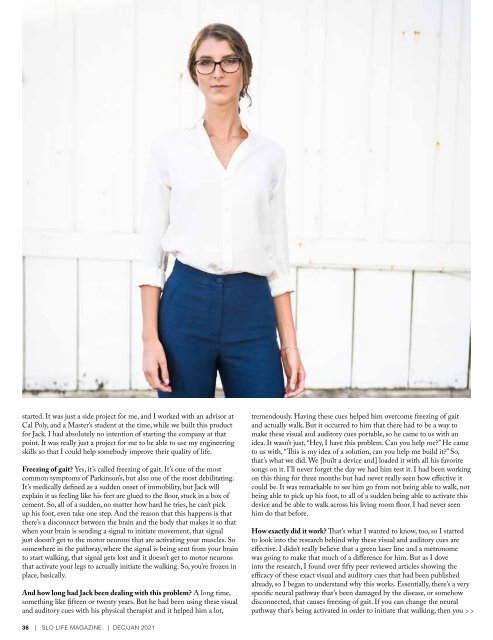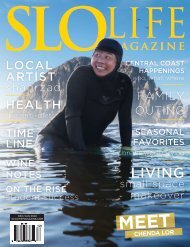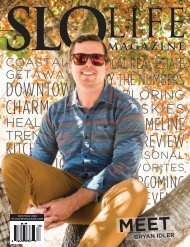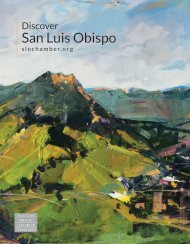Create successful ePaper yourself
Turn your PDF publications into a flip-book with our unique Google optimized e-Paper software.
started. It was just a side project for me, and I worked with an advisor at<br />
Cal Poly, and a Master’s student at the time, while we built this product<br />
for Jack. I had absolutely no intention of starting the company at that<br />
point. It was really just a project for me to be able to use my engineering<br />
skills so that I could help somebody improve their quality of life.<br />
Freezing of gait? Yes, it’s called freezing of gait. It’s one of the most<br />
common symptoms of Parkinson’s, but also one of the most debilitating.<br />
It’s medically defined as a sudden onset of immobility, but Jack will<br />
explain it as feeling like his feet are glued to the floor, stuck in a box of<br />
cement. So, all of a sudden, no matter how hard he tries, he can’t pick<br />
up his foot, even take one step. And the reason that this happens is that<br />
there’s a disconnect between the brain and the body that makes it so that<br />
when your brain is sending a signal to initiate movement, that signal<br />
just doesn’t get to the motor neurons that are activating your muscles. So<br />
somewhere in the pathway, where the signal is being sent from your brain<br />
to start walking, that signal gets lost and it doesn’t get to motor neurons<br />
that activate your legs to actually initiate the walking. So, you’re frozen in<br />
place, basically.<br />
And how long had Jack been dealing with this problem? A long time,<br />
something like fifteen or twenty years. But he had been using these visual<br />
and auditory cues with his physical therapist and it helped him a lot,<br />
tremendously. Having these cues helped him overcome freezing of gait<br />
and actually walk. But it occurred to him that there had to be a way to<br />
make these visual and auditory cues portable, so he came to us with an<br />
idea. It wasn’t just, “Hey, I have this problem. Can you help me?” He came<br />
to us with, “This is my idea of a solution, can you help me build it?” So,<br />
that’s what we did. We [built a device and] loaded it with all his favorite<br />
songs on it. I’ll never forget the day we had him test it. I had been working<br />
on this thing for three months but had never really seen how effective it<br />
could be. It was remarkable to see him go from not being able to walk, not<br />
being able to pick up his foot, to all of a sudden being able to activate this<br />
device and be able to walk across his living room floor. I had never seen<br />
him do that before.<br />
How exactly did it work? That’s what I wanted to know, too, so I started<br />
to look into the research behind why these visual and auditory cues are<br />
effective. I didn’t really believe that a green laser line and a metronome<br />
was going to make that much of a difference for him. But as I dove<br />
into the research, I found over fifty peer reviewed articles showing the<br />
efficacy of these exact visual and auditory cues that had been published<br />
already, so I began to understand why this works. Essentially, there’s a very<br />
specific neural pathway that’s been damaged by the disease, or somehow<br />
disconnected, that causes freezing of gait. If you can change the neural<br />
pathway that’s being activated in order to initiate that walking, then you >><br />
36 | <strong>SLO</strong> <strong>LIFE</strong> MAGAZINE | DEC/JAN <strong>20</strong><strong>21</strong>


















